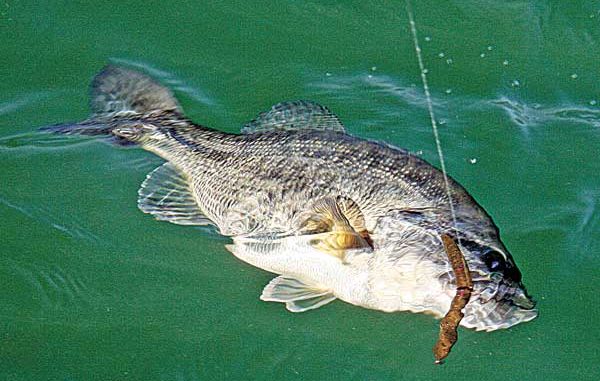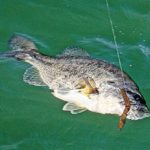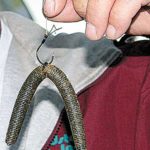
This versatile rig appeals to bass in multiple springtime scenarios.
It may look like you’ve snagged a piece of debris, or maybe you forgot to reset your bait after the last strike, but the truth about wacky rigs is undeniable — these seemingly random arrangements catch fish when many other lures fail to impress picky bass. Despite its unconventional appearance and a seemingly random arrangement, the wacky rig can be an effective presentation in many different scenarios. Hooked dead center, a wacky-rigged worm undulates, wiggles, shimmies and shakes — all to the delight of lurking largemouths — with not much more than a cast.
A very user-friendly bait, the wacky worm is truly a bait for all seasons.
“You can use a wacky worm anytime, anywhere. You don’t even have to be able to cast very far. If you can get it out there, you can catch fish,” said Toledo Bend guide Glen Freeman, adding that the wacky rig is his go-to bait. “I (use) it whenever I can’t get bit on anything else. The slow movement as opposed to how you’d work any other lure is what attracts the fish.”
Of course, there are plenty of occasions for going wacky from the start. Freeman’s prime wacky-rig scenario is what he calls a “slick bank” — one with little obvious attraction.
“These are the places that most people don’t fish because they’re looking for grass or other structure,” he said. “The fish don’t see a lot of baits in these places, so when you throw a wacky rig, it’s very effective.”
BASS pro and 2005 Bass Masters Classic Champion Mike Iaconelli agrees.
“Wacky rigs are especially effective in spring, from the pre-spawn to the post-spawn periods,” he said. “But this also works in the summertime. When it gets hot, bass go to deep water, shade or current. If you have any of those scenarios, a wacky rig will be (productive).”
Wacky worms do a good job of imitating actual invertebrates, but the quivering motion also looks like the natural movement of various forage — from a dying shad to a crawfish scurrying across the bottom.
“I think the real key is that it’s something subtle, something natural,” he said. “For fish, it’s such an easy meal. It’s such a natural appearance — they just have to suck it in.”
Good thing is that this enticement is predominantly self-generated.
“It’s a bait that does the work for you,” Iaconelli said. “It’s not a bait that you have to work (actively) or give a hard pump to impart the action. About 70 percent of the bites that occur with a wacky rig occur on the fall, when you’re not doing anything.”
Indeed, the fall of a wacky rig is the whole show, and savvy anglers have developed several tricks for making the worm fall just the way they want it to.
That sinking feeling
Now the subject of weighting wacky rigs fosters much creativity, and variations run the gamut of external to internal options. Desired sink rates vary with depth, and the amount of weight needed varies with worm size. Sometimes a dense soft-plastic stickbait like the classic Senko does the trick, while other scenarios favor light finesse worms.
Freeman likes the Yum Dinger for spring’s prespawn through post-spawn period. For summer patterns, he’ll switch to a Yum Houdini worm. With the Dinger, he’ll add a 1/16-ounce bullet weight above the hook. For the lighter Houdini worm, he’ll insert a small nail into the head.
“That will give the baits just a touch of a nose dive, but when you pull back on it, the bait will flatten back out, so you have the best of both worlds,” he said.
Iaconelli has also used nails, but he found that inconsistent insertions during the pressured constraints of tournament competition left him with undependable worm action. Tru-Tungsten has solved that problem with an innovative design that adds tungsten powder to the heads or tails of their finesse worms. The benefit is a reliable sink rate defined by bait size and weight.
The 6½-inch Stinger and 5-inch Dart come in head- and tail-weighted (reverse) styles, each with sink-rate options of a half foot per second and a foot per second. Iaconelli said this system eliminates the guessing game of nail insertions.
“This has the perfect fall 10 times out of 10,” he said. “It’s almost like using a crankbait. You’re able to dial in on which worm you need. The tungsten powder has made this type of fishing so much easier.”
Iaconelli suggests weighted worms with sink rates of half a foot per second for depths of a foot to 6 feet. In 6 feet or more, he’ll use worms with the foot-per-second sink rate. In depths of a foot or less, unweighted wacky rigs are the way to go.
Although he likes the Tru-Tungsten forward and reverse options, Iaconelli is partial to the head-weighted worms.
“I feel like you’re putting the weight in the thicker part of the worm so you get more angle to the fall,” he said. “Things in nature fall head first at an angle when they’re dying, so this looks most natural.”
When you get into depths greater than about 10 feet, anglers often replace a bare hook with a wacky-style jighead. The extra weight sinks the bait faster, while the jighead angles the worm upward when sitting on the bottom for optimal presentation and minimal snagging.
In deep scenarios, fishing the wacky-rigged worm on a dropshot also works well. The strategy with this and the jighead option is to simply get the bait into the strike zone quicker than a free fall. Also, current may sweep light wacky worms off course, while heavier rigs keep them on course to where you want them.
“It becomes a game of time,” Iaconelli said. “You have to wait so long for (an unweighted) bait to fall. (Heavier rigs) allow you to get a wacky worm down quicker.”
Additionally, the use of O-rings allows anglers to achieve the wacky presentation while keeping the majority of their hook free, thus minimizing the possibility of the worm impeding a hook-up. From an economic standpoint, O-rings can minimize your bait expenditure by preventing most baits from getting ripped up during the bite and fight.
Using a 1/0 finesse wide gap hook, Iaconnelli employs O-rings for larger soft stick baits like the classic Senko, but for traditional finesse worms, he runs his hook right through the worm. In areas of thick cover, hooks with weed guards will minimize snagging.
As Iaconelli notes, a wacky rig can be skipped easily, so it’s a handy option for reaching the big bass that hunker down, deep beneath shady docks. He uses a short, snappy cast — similar to a baseball player’s check swing — to reach beneath the cover.
Here, and in all scenarios, the wacky’s slow, fluttering descent gives it a more attractive fall rate than that of a jig or Texas-rigged worm.
“The wacky rig will quiver with both ends shaking, and that’s so much more natural than something falling 90 m.p.h. to the bottom,” he said.
Presentation
Baitcasting or spinning gear works for wacky presentations. Freeman prefers the latter because he’s often fishing areas of heavy cover, and baitcasting gear gives him the confidence to horse a big fish from his fortress.
Iaconelli is a spinning outfit guy, but he says the key component is 8- to 10-pound fluorocarbon line. Abrasion resistance and low visibility are integral benefits, but fluoro’s dense composition helps sink a wacky bait faster with less weight. In super-heavy cover, Iaconelli runs 6-pound braided main line with a 12-pound fluorocarbon leader.
The key, he said, is to let the bait fall on a semi-slack line — not too tight, not too loose. Using the rod and your body in one fluid motion, “bow down” with the worm’s descent so the line remains semi-taut. Once it hits bottom, raise the rod to subtly twitch the bait, and then repeat the routine for several movements on each spot.
Freeman has caught fish up to 8 pounds on wacky rigs. In most cases, the strike has been nearly imperceptible.
“It’s a very light bite,” he said. “In fact, a lot of times, you won’t even feel the bite with a wacky rig, so you have to maintain visual contact with your line.”
Iaconelli agrees.
“I use the three-second rule,” he said. “When you see anything different — I go one, two, three, and use a sweeping hookset. You’re using your body; you’re leaning back and sweeping your rod to the side. The wacky rig is a high-percentage hook-up bait. You probably catch 90 percent of the fish you hook. They don’t let go of this bait.”
It all starts with the critical first impression.
“Biologically, the bass sees something falling next to him, and he instinctively knows he should eat it,” Iaconelli said. “But you also have the reaction instinct when the bait suddenly appears. Any bait that can appeal to both instincts, that’s a great bait to throw.”






